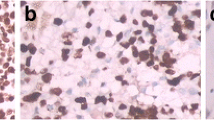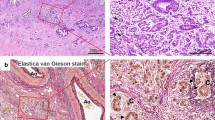Abstract
Background
Although receptor activator of nuclear factor-κB ligand (RANKL) seems to be involved in the development of bone metastases in several malignant tumors, its role in hepatocellular carcinoma (HCC) has not been investigated.
Methods
We retrospectively examined the immunohistochemical expression of RANKL in formalin-fixed, paraffin-embedded resected specimens obtained from 96 patients with HCC with (n = 16) and without (n = 80) bone metastases. In addition, tumor RANKL mRNA expression was evaluated by reverse transcriptase–polymerase chain reaction (RT-PCR) in five selected patients. We analyzed the relationship between RANKL expression level, bone metastasis development, and survival rate of patients with HCC after hepatic resection.
Results
Of the 96 patients with HCC, serum hepatitis C virus antibody was detected in 43.5% of patients and hepatitis B surface antigen in 29.5% of patients. Thirty-three patients (36.5%) also had liver cirrhosis. Immunohistochemical analysis showed that RANKL protein was present in 10 (62.5%) of 16 patients with HCC with bone metastasis compared with 21 (26.3%) of 80 patients with HCC without bone metastasis; we found that RANKL expression was statistically significantly correlated to bone metastasis development (P < .01). RANKL mRNA expression was confirmed by RT-PCR in patients positive for RANKL protein expression by immunohistochemistry. The 5-year cancer-related (P < .01) and disease-free survival (P < .01) rates after hepatic resection were statistically significantly worse in patients positive for RANKL expression compared with RANKL-negative patients.
Conclusions
Some HCC cells produced the crucial bone resorption regulator RANKL. Because RANKL modulates bone turnover, its presence would have profound implications for the establishment and development of bone metastases.



Similar content being viewed by others
References
Vivarelli M, Guglielmi A, Ruzzenente A, et al. Surgical resection versus percutaneous radiofrequency ablation in the treatment of hepatocellular carcinoma on cirrhotic liver. Ann Surg 2004;240:102–7
Ercolani G, Grazi GL, Ravaioli M, et al. Liver resection for hepatocellular carcinoma on cirrhosis: univariate and multivariate analysis of risk factors for intrahepatic recurrence. Ann Surg 2003;237:536–43
Sasaki A, Iwashita Y, Shibata K, et al. Prognostic value of preoperative peripheral blood monocyte count in patients with hepatocellular carcinoma. Surgery 2006;139:755–64
Hanazaki K, Kajikawa S, Shimozawa N, et al. Survival and recurrence after hepatic resection of 386 consecutive patients with hepatocellular carcinoma. J Am Coll Surg 2000;191:381–8
Sasaki A, Kai S, Iwashita Y, Hirano S, Ohta M, Kitano S. Microsatellite distribution and indication for locoregional therapy in small hepatocellular carcinoma. Cancer 2005;103:299–306
Poon RTP, Fan ST, Lo CM, et al. Improving survival results after resection of hepatocellular carcinoma: a prospective study of 377 patients over 10 years. Ann Surg 2001;234:63–70
Katyal S, Oliver JH III, Peterson MS, Ferris JV, Carr BS, Baron RL. Extrahepatic metastases of hepatocellular carcinoma. Radiology 2000;216:698–703
Iwata M, Kaneko S, Terasaki S, et al. Importance of achieving complete necrosis during the first treatment for hepatocellular carcinoma to prevent bone metastasis: a prospective study. J Gastroenterol Hepatol 2001;16:46–51
Taki Y, Yamaoka Y, Takayasu T, et al. Bone metastases of hepatocellular carcinoma after liver resection. J Surg Oncol 1992;50:12–8
Kubo S, Hirohashi K, Tanaka H, et al. Risk factors for recurrence after resection of hepatitis C virus–related hepatocellular carcinoma. World J Surg 2000;24:1559–65
Kaizu T, Karasawa K, Tanaka Y, et al. Radiotherapy for osseous metastases form hepatocellular carcinoma;a retrospective study of 57 patients. Am J Gastroenterol 1998;93:2167–71
Natsuizaka M, Omura T, Akaike T, et al. Clinical feature of hepatocellular carcinoma with extrahepatic metastases. J Gastroenterol Hepatol 2005;20:1781–7
Paget S. The distribution secondary growths in cancer of the breast [originally published 1889]. Cancer Metastasis Rev 1989;8:98–101
Suda T, Takahashi N, Udagawa N, Jimi E, Gillepsie MT, Martin TJ. Modulation of osteoclast differentiation and function by the new members of the tumor necrosis factor receptor and ligand families. Endocr Rev 1999;20:345–57
Wong BR, Josien R, Choi Y. TRANCE is a TNF family member that regulates dendritic cell and osteoclast function. J Leukoc Biol 1999;65:715–24
Dunstan CR. Osteoprotegrin and osteoprotegrin ligand mediate the local regulation of bone resorption. Endocrinologist 2000;10:18–26
Hofbauer LC, Khosla S, Lancey DL, Dunstan CR, Boyle WJ, Riggs BL. The role of osteoprotegrin and osteoprotegrin ligand in the paracrine regulation of bone resorption. J Bone Miner Res 2000;15:2–12
Yasuda H, Shima N, Nakagawa N, et al. Osteoclast differentiation factor is a ligand for osteoprotegrin/osteoclastogenesis-inhibitory factor and is identical to TRANCE/RANKL. Proc Natl Acad Sci U S A 1998;95:3597–602
Lacey DL, Timms E, Tan HL, et al. Osteoprotegrin (OPG) ligand is a cytokine that regulates osteoclast differentiation and activation. Cell 1998;93:165–76
Wong BR, Rho J, Arron J, et al. TRANCE is a novel ligand of the tumor necrosis factor receptor family that activates c-jun N-terminal kinase in T cells. J Biol Chem 1997;272:25190–4
Kartsogiannis V, Zhou H, Horwood NJ, et al. Localization of RANKL (receptor activator of NFκB ligand) mRNA and protein in skeletal and extraskeletal tissues. Bone 1999;25:525–34
Anderson DM, Maraskovsky E, Billingsley WL, et al. A homologue of the TNF receptor and its ligand enhance T-cell growth and dendritic cell function. Nature 1997;390:175–9
Brown JM, Corey E, Lee ZD, et al. Osteoprotegrin and RANK ligand expression in prostate cancer. Urology 2001;57:611–6
Michigami T, Ihara-Watanabe M, Yamazaki M, Ozono K. Receptor activator of nuclear factor kappaB ligand (RANKL) is a key molecule of osteoclast formation for bone metastasis in a newly developed model of human neuroblastoma. Cancer Res 2001;61:1637–44
Huang L, Cheng YY, Chow LT, Zheng MH, Kumta SM. Receptor for activator of NF-kappaB ligand (RANKL) is expressed in chondroblastoma: possible involvement in osteoclastic giant cell recruitment. Mol Pathol 2003;56:116–20
Huang L, Xu J, Wood DJ, Zheng MH. Gene expression of osteoprotegrin ligand, osteoprotegrin, and receptor activator of NF-κB in giant cell tumor of bone. Am J Pathol 2000;156:761–7
Liver Cancer Study Group of Japan. General Rules for the Clinical and Pathological Study of Primary Liver Cancer. 2nd English ed. Tokyo: Kanehara, 2003
Mimori K, Shiraishi T, Mashino K, et al. MAL gene expression in esophageal cancer suppresses motility, invasion and tumorigenicity and enhances apoptosis through the Fas pathway. Oncogene 2003;22:3463–71
Sugiyama M, Sakahara H, Torizuka T, et al. 18F-FDG PET in the detection of extrahepatic metastasis from hepatocellular carcinoma. J Gastroenterol 2004;39:961–8
Good CR, O’Keefe RJ, Puzas JE, Schwarz EM, Rosier RN. Immunohistochemical study of receptor activator of nuclear factor kappa-B ligand (RANK-L) in human osteolytic bone tumors. J Surg Oncol 2002;79:174–9
Huang L, Cheng YY. Tumor cells produce receptor activator of NF-B ligand (RANKL) in skeletal metastases. J Clin Pathol 2002;55:877–8
Thomas RJ, Guise TA, Yin JJ, et al. Breast cancer cells interact with osteoblasts to support osteoclast formation. Endocrinology 1999;140:4451–8
Bouizar Z, Spyratos F, Deytieux S, de Vernejoul MC, Jullienne A. Polymerase chain reaction analysis of parathyroid hormone-related protein gene expression in breast cancer patients and occurrence of bone metastases. Cancer Res 1993;53:5076–8
Bhatia P, Sanders MM, Hansen MF. Expression of receptor activator of nuclear factor-kappaB is inversely correlated with metastatic phenotype in breast carcinoma. Clin Cancer Res 2005;11:162–5
Roskams T, Willems M, Campos RV, Drucker DJ, Yap SH, Desmet VJ. Parathyroid hormone-related peptide expression in primary and metastatic liver tumours. Histopathology 1993;23:519–25
Leslie WD, Bernstein CN, Leboff MS. AGA technical review on osteoporosis in hepatic disorders. Gastroenterology 2003;125:941–66
Szalay F, Hegedus D, Lakatos PL, et al. High serum osteoprotegrin and low RANKL in primary biliary cirrhosis. J Hepatol 2003;38:395–400
Fábrega E, Orive A, Garcia-Suarez C, Garcia-Unzueta M, Antonio Amado J, Pons-Romero F. Osteoprotegerin and RANKL in alcoholic liver cirrhosis. Liver Int 2005;25:305–10
Moschen AR, Kaser A, Stadlmann S, et al. The RANKL/OPG system and bone mineral density in patients with chronic liver disease. J Hepatol 2005;43:973–83
Terpos E, Szydlo R, Apperley JF, et al. Soluble receptor activator of nuclear factor kappaB ligand-osteoprotegerin ratio predicts survival in multiple myeloma: proposal for a novel prognostic index. Blood 2003;102:1064–9
Zhang J, Dai J, Yao Z, Lu Y, Dougall W, Keller ET. Soluble receptor activator of nuclear factor kappaB Fc diminishes prostate cancer progression in bone. Cancer Res 2003;63:7883–90
Honore P, Luger NM, Sabino MNC, et al. Osteoprotegrin blocks bone cancer-induced skeletal destruction, skeletal pain and pain-related neurochemical reorganization of the spiral cord. Nat Med 2000;6:521–8
Ohnishi T, Takeda E, Yogita S, et al. Effects of alendronate on bone metastases and hypercalcemia after surgery for hepatocellular carcinoma. Jpn J Clin Oncol 2000;30:410–3
Acknowledgments
Presented in part at The Society of Surgical Oncology 59th Annual Cancer Symposium, March 23–26, 2006, San Diego, CA. This work was supported in part by a Grant-in-Aid for Scientific Research from the Japanese Ministry of Education, Culture, Sports, Science, and Technology (grant 16591329), Core Research for Evolutional Science and Technology (CREST), Japan Science and Technology Agency, and Japan Society for the Promotion of Science Grants-in-Aid for Scientific Research (grants 17109013, 17591411, and 17591413). The authors thank MS. Yuko Nakagawa and Fusayo Kawamura for their technical assistance with the immunohistochemistry, and Yuichi Endo M.D. and MS. Kazue Ogata for assistance with the reverse transcriptase–polymerase chain reaction analysis.
Author information
Authors and Affiliations
Corresponding author
Rights and permissions
About this article
Cite this article
Sasaki, A., Ishikawa, K., Haraguchi, N. et al. Receptor Activator of Nuclear Factor-κB Ligand (RANKL) Expression in Hepatocellular Carcinoma With Bone Metastasis. Ann Surg Oncol 14, 1191–1199 (2007). https://doi.org/10.1245/s10434-006-9277-4
Received:
Revised:
Accepted:
Published:
Issue Date:
DOI: https://doi.org/10.1245/s10434-006-9277-4




